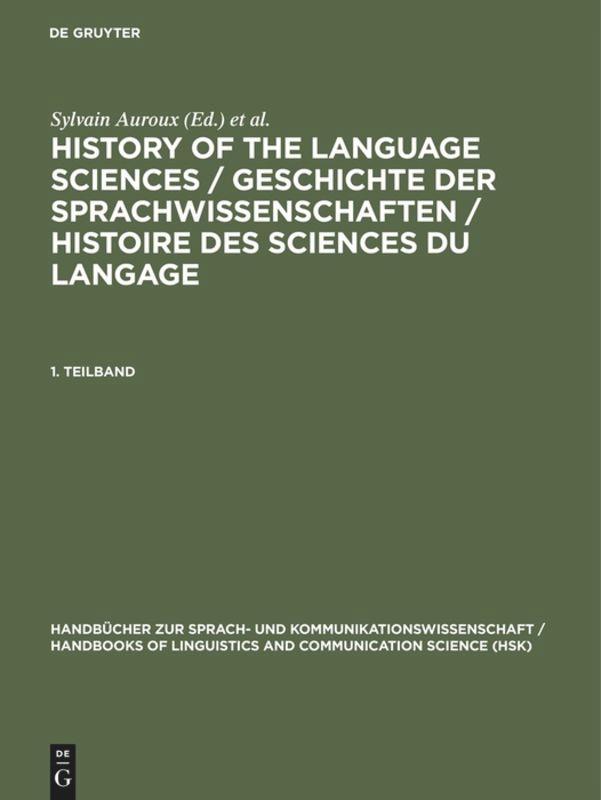No detailed description available for "HISTORY OF LANGUAGE SCIENCES (KOERNER) 1. TLBD HSK 18. 1".
Inhaltsverzeichnis
1; Contents / Inhalt / Table des matieres; 5
2; Editors Foreword; 24
2. 1; 1. General introduction; 24
2. 1. 1; 1. 1 Definition; 24
2. 1. 2; 1. 2 Scope; 25
2. 1. 3; 1. 3 Themes; 26
2. 1. 4; 1. 4 State of the art; 27
2. 1. 5; 1. 5 Structure of the Handbook; 29
2. 2; 2. Description of Individual Chapters; 30
3; Vorwort der Herausgeber; 36
3. 1; 1. Allgemeine Einleitung; 36
3. 1. 1; 1. 1 Begriffsbestimmungen; 36
3. 1. 2; 1. 2 Gegenstandsbereich; 37
3. 1. 3; 1. 3 Thematische Schwerpunkte; 38
3. 1. 4; 1. 4 Forschungsstand; 40
3. 1. 5; 20. Jahrhunderts informiert. In anderen vielbändigen Handbüchern zur Geschichte der; 42
3. 1. 6; 1. 5 Aufbau des Handbuchs; 42
3. 2; 2. Erläuterungen zu den einzelnen Kapiteln; 43
3. 2. 1; 17. Jahrhunderts wieder an Bedeutung; sie rufen namentlich im 18. Jahrhundert großes45
3. 2. 2; 20. Jahrhunderts. Damit verbundene Arbeiten auf dem Gebiete der Lexikographie sind; 45
3. 2. 3; 20. Jahrhundert kommt es zur Herausbildung verschiedener Schulen und Forschungs-einrichtungen, ; 46
3. 2. 4; 19. Jahrhundert, wo die Bedeutung der Indianersprachen für die Sprachforschung er-kannt; 46
4; Preface des editeurs; 48
4. 1; 1. Ge ne ralite s; 48
4. 1. 1; 1. 1 De finitions; 48
4. 1. 2; 1. 2 Envergure; 49
4. 1. 3; 1. 3 Les dominantes the matiques; 50
4. 1. 4; 1. 4 L e tat de la recherche; 52
4. 1. 5; 1. 5 Structure du manuel; 54
4. 1. 6; 2. Commentaires sur les diffe rents chapitres; 55
5; I. The Establishment of Linguistic Traditions in the Near East Die Anfänge sprachwissenschaftlicher Traditionen im Nahen Osten La constitution des traditions linguistiques au Proche-Orient; 60
5. 1; 1. The Sumerian and Akkadian linguistic tradition; 60
5. 1. 1; 1. Writing and languages; 60
5. 1. 2; 2. Scribal training; 61
5. 1. 3; 3. Akkadian lists; 62
5. 1. 4; 4. Linguistic consciousness; 63
5. 1. 5; 5. Bibliography; 63
5. 2; 2. Indigenous Egyptian grammar; 64
5. 2. 1; 1. Introductory remarks; 64
5. 2. 2; 2. Natural semantics: Paronomasia; 65
5. 2. 3; 3. Systematic formation: Schooling; 65
5. 2. 4; 4. Grammatical theory; 66
5. 2. 5; 5. Indigenous linguistic terminology; 66
5. 2. 6; 6. Practical philology, diglossia; 67
5. 2. 7; 7. Lexical work; 68
5. 2. 8; 8. Foreign languages; 69
5. 2. 9; 9. The concept of language; 71
5. 2. 10; 10. Bibliography; 71
5. 3; 3. Die Sprachforschung in Ugarit; 73
5. 3. 1; 1. Einleitung; 73
5. 3. 2; 2. Einheimische Schriftdenkmäler im; 74
5. 3. 3; 3. Einheimische Schriftdenkmäler im; 75
5. 3. 4; 4. Bibliographie; 76
6; II. The Establishment of the Chinese Linguistic Tradition Die Anfänge der Sprachwissenschaft in China La constitution de la tradition linguistique chinoise; 78
6. 1; 4. Classical Chinese philosophies of language: Logic and ontology; 78
6. 1. 1; 1. Two aspects of language in early; 78
6. 1. 2; 2. Nature and function of non-substantive; 81
6. 1. 3; 3. Five positions (theories) of words; 83
6. 1. 4; 4. The Confucian doctrine; 84
6. 1. 5; 5. The Daoist doctrine of wu-ming; 86
6. 1. 6; 6. Nominalistic tendencies in Yinwenzi; 88
6. 1. 7; 7. Platonistic tendencies in Gongsun; 89
6. 1. 8; 8. The empirical (scientific) realism; 92
6. 1. 9; 9. Concluding remarks; 94
6. 1. 10; 10. Bibliography; 94
6. 2; 5. The Sui -Ta ng tradition of Fa. nqie` phonology; 95
6. 2. 1; 1. Introduction; 95
6. 2. 2; 2. The origins of Fa. nqie`; 97
6. 2. 3; 3. Aesthetics of Fa. nqie` organization; 98
6. 2. 4; 4. The Qie`yu`n rime-book; 99
6. 2. 5; 5. The significance of the Qie`yu`n; 100
6. 2. 6; 6. Prosody and other linguistic ideas; 103
6. 2. 7; 7. Bibliography; 104
6. 3; 6. The rime-table system of formal Chinese phonology; 105
6. 3. 1; 1. Introduction; 105
6. 3. 2; 2. The formal system of rime-table; 106
6. 3. 3; 3. Phonological categories and their; 107
6. 3. 4; 4. Classification of initials; 107
6. 3. 5; 5. Classification of rimes; 108
6. 3. 6; 6. Origins; 109
6. 3. 7; 7. Higher structures of the; 110
6. 3. 8; 8. Other technical terminology; 112
6. 3. 9; 9. Chinese alphabets; 112
6. 3. 10; 10. Bibliography; 113
6. 4; 7. Le ro le du savoir linguistique dans l e ducation et la socie te chinoise; 114
6. 4. 1; 1. Introduction; 114
6. 4. 2; 2. Avant l instauration des examens; 114
6. 4. 3; 3. Apre`s l institution des examens; 115
6. 4. 4; 4. Conclusion; 116
6. 4. 5; 5. Bi













